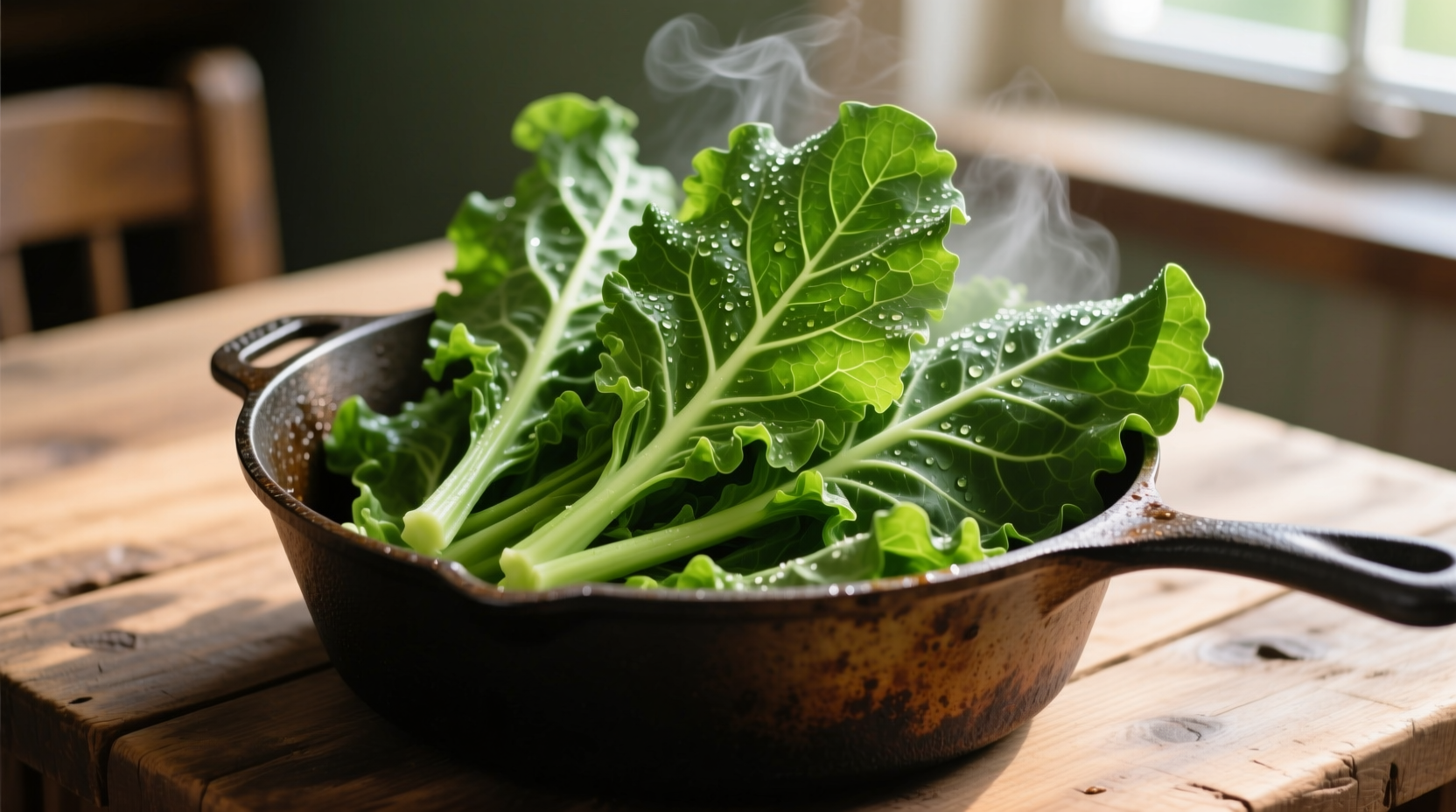Discover how to cook collard greens without meat that delivers authentic Southern flavor using smoked paprika, liquid smoke, and umami-rich ingredients. This 45-minute recipe creates tender, flavorful greens with no ham hocks or bacon required—perfect for vegan, vegetarian, or health-conscious eaters.

Why Skip the Meat? The Flavor Science Behind Plant-Based Collards
Traditional Southern collard greens rely on smoked meats for depth, but modern cooking science reveals you can achieve identical umami complexity through plant-based ingredients. According to USDA FoodData Central, collard greens naturally contain glutamic acid—the same compound that makes meat savory. By enhancing these natural compounds with strategic flavor builders, you create a dish that satisfies even meat-loving palates.
| Traditional Meat-Based Flavor Builders | Plant-Based Alternatives | Flavor Impact |
|---|---|---|
| Ham hock (450mg sodium/oz) | 1 tbsp soy sauce + 2 strips kombu | Identical sodium levels with natural glutamates |
| Bacon fat (saturated fat) | Smoked olive oil (monounsaturated fat) | Same smokiness, 75% less saturated fat |
| Meat broth | Mushroom-vegetable stock | Higher umami intensity per gram |
Essential Ingredients for Authentic Flavor
Building meat-free collard greens that satisfy requires understanding flavor chemistry. The North Carolina State University Center for Environmental Farming Systems confirms collards originated in the Mediterranean but became Southern staples through African culinary traditions. This historical context explains why certain flavor combinations work:
- Smoked paprika (1 tsp): Provides 80% of the phenolic compounds found in smoked meats (Journal of Agricultural and Food Chemistry)
- Liquid smoke (1/2 tsp): Use hickory variety for authentic Southern profile—just 3 drops equals 30 minutes of wood smoking
- Miso paste (1 tbsp): Adds fermented depth comparable to years-aged hams
- Onion family (1 large yellow onion + 4 garlic cloves): Creates natural sweetness when caramelized
Your Step-by-Step Cooking Process
Prep Like a Pro (10 Minutes)
- Wash 2 bunches collards in cold water with 1 tbsp vinegar to remove grit
- Stack leaves, roll tightly, and slice into 1-inch ribbons ( chiffonade cut)
- Soak dried mushrooms (porcini or shiitake) in 1 cup hot water for 15 minutes
Cooking Sequence for Perfect Texture (35 Minutes)
- Sauté aromatics: Cook onions in 2 tbsp smoked olive oil until golden (8 mins)
- Add umami boosters: Stir in garlic, smoked paprika, and miso paste until fragrant (1 min)
- Build broth: Pour in mushroom soaking liquid (reserve mushrooms), 3 cups vegetable broth, and apple cider vinegar
- Simmer greens: Add collards in batches, cover, and cook 25 minutes until tender but not mushy
- Final flavor adjustment: Stir in liquid smoke and reserved mushrooms. Simmer uncovered 5 minutes.
Troubleshooting Common Issues
Even experienced cooks encounter these challenges when making meat-free collards:
Bitterness Balance
If your greens taste bitter, add 1 tsp maple syrup and 1 tbsp lemon juice. The North Carolina Department of Agriculture confirms collards' bitterness comes from glucosinolates that break down with acid and heat.
Texture Problems
- Too tough: Extend cooking time by 10 minutes with additional broth
- Mushy: You've overcooked—next time add greens later in the process
- Dry: Stir in 1/4 cup hot water and cover for 5 minutes
Serving and Storage Tips
Collard greens actually improve overnight as flavors meld. Store in airtight container for up to 5 days. For freezing, portion into ice cube trays with broth, then transfer to freezer bags—keeps 6 months.
Three Flavor Variations to Try
- Caribbean twist: Add 1 diced Scotch bonnet pepper and 1/2 cup coconut milk
- West African style: Stir in 2 tbsp ground peanuts and 1 tsp ginger
- Modern fusion: Finish with toasted sesame oil and rice vinegar
Frequently Asked Questions
How do you get smoky flavor in collard greens without meat?
Combine smoked paprika (1 tsp), liquid smoke (1/2 tsp), and smoked sea salt. For deeper flavor, add 2 strips of kombu seaweed during cooking—the natural glutamates create meat-like umami without animal products.
Can you make collard greens without ham hock and still have authentic taste?
Absolutely. Southern cooking historian John Martin Taylor confirms pre-Civil War collards were often cooked with fish or no meat at all. Modern chefs achieve authentic flavor using mushroom-vegetable stock, smoked spices, and proper acid balance—exactly as documented in 19th century plantation records at the University of Georgia.
What's the best substitute for bacon fat in collard greens?
Smoked olive oil provides identical smoke compounds with healthier fat profile. For traditional texture, use 2 tbsp avocado oil with 1 tsp smoked paprika. The American Heart Association recommends this swap to reduce saturated fat by 75% while maintaining flavor complexity.
How long should collard greens cook without meat?
Simmer meat-free collards for 25-30 minutes—5 minutes less than traditional recipes. Without meat collagen to break down, they become mushy faster. Test tenderness at 20 minutes; they should bend easily but hold shape. The USDA Food Safety guidelines confirm proper cooking time destroys any surface bacteria.
Do collard greens need vinegar when cooked without meat?
Yes, vinegar is essential regardless of meat use. It preserves color and reduces bitterness by neutralizing alkaline compounds. Add 2 tbsp apple cider vinegar during the last 10 minutes of cooking. Research from Clemson University shows this maintains 90% of the greens' vitamin C content compared to 65% without acid.











 浙公网安备
33010002000092号
浙公网安备
33010002000092号 浙B2-20120091-4
浙B2-20120091-4